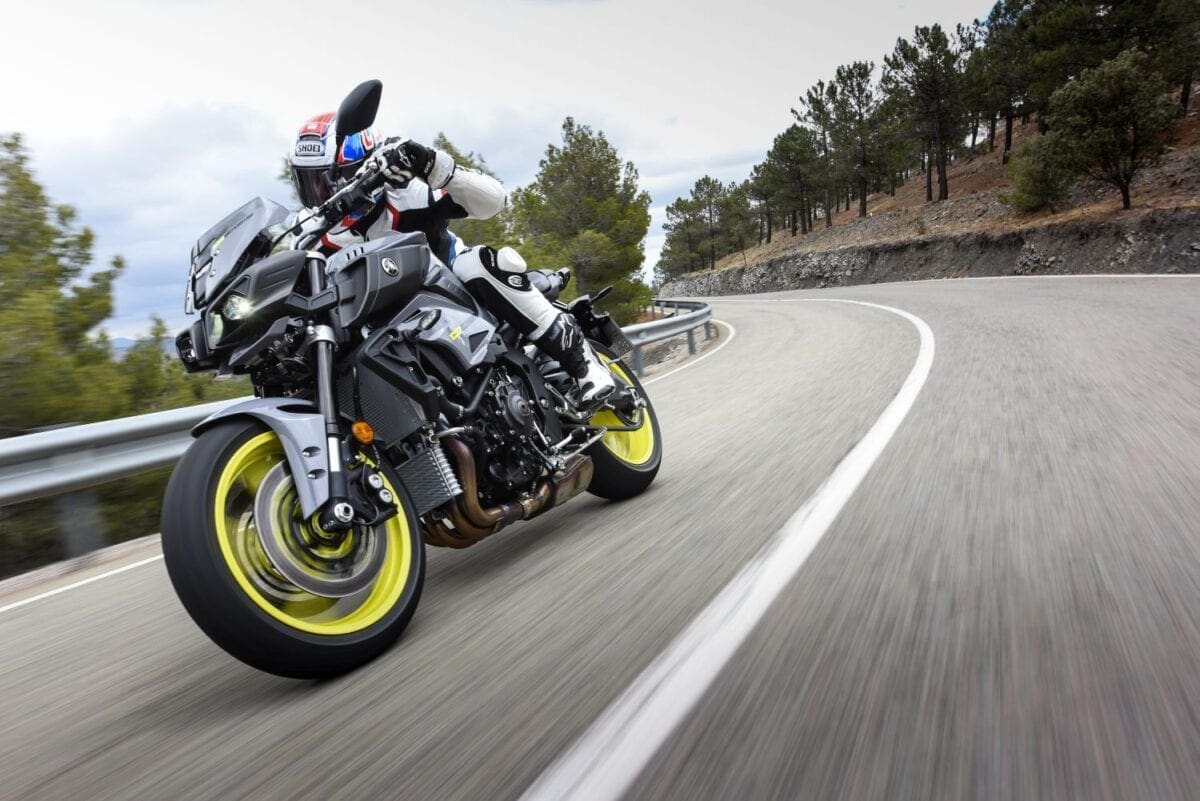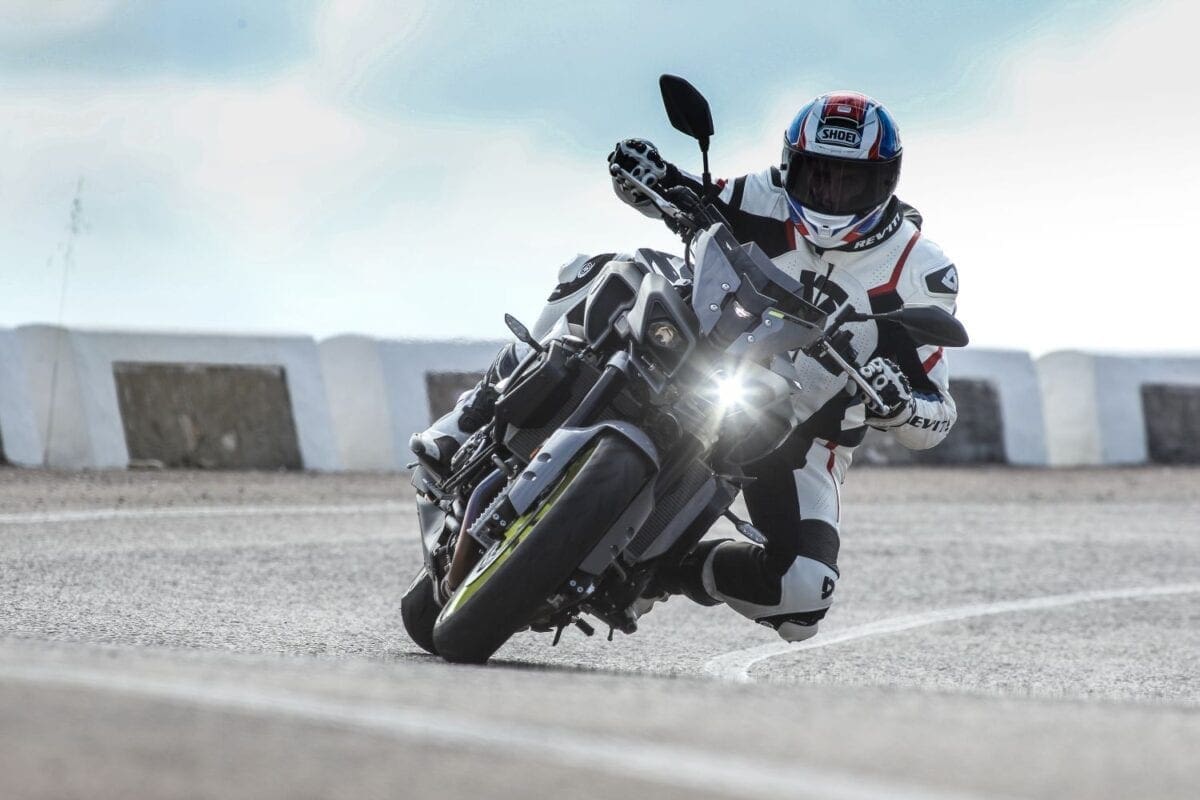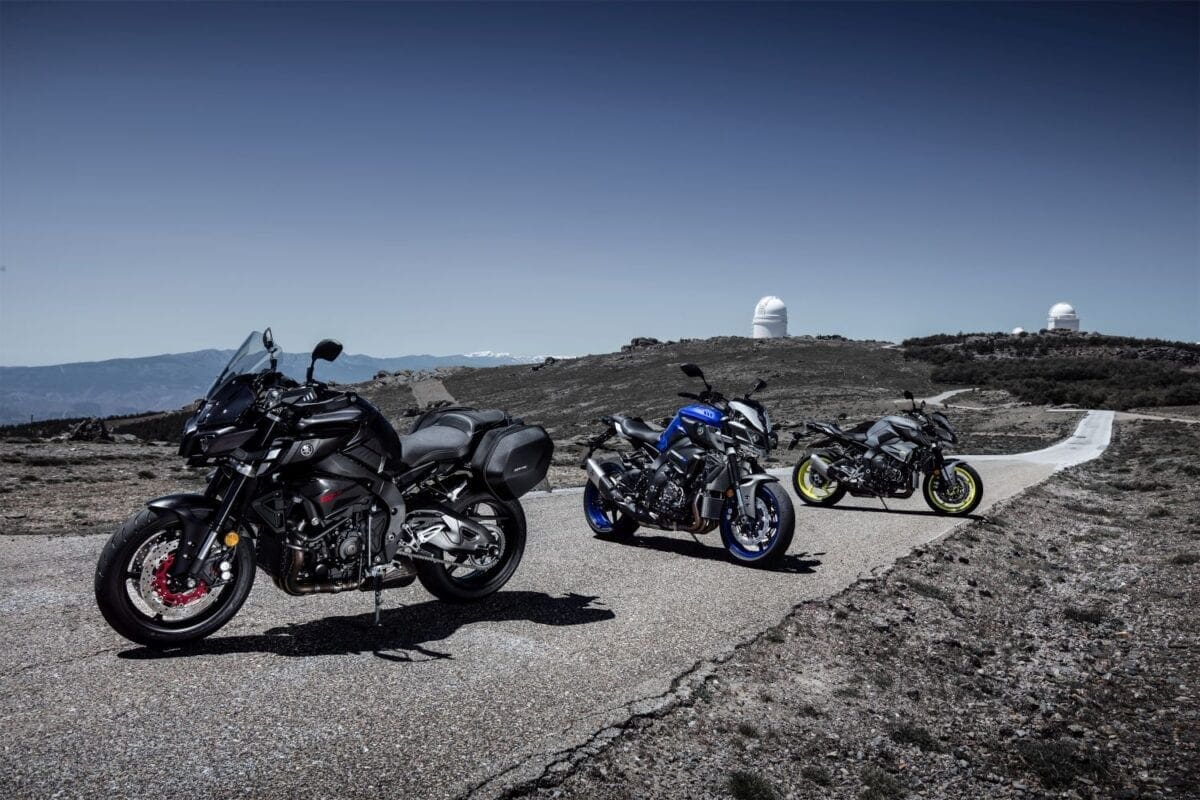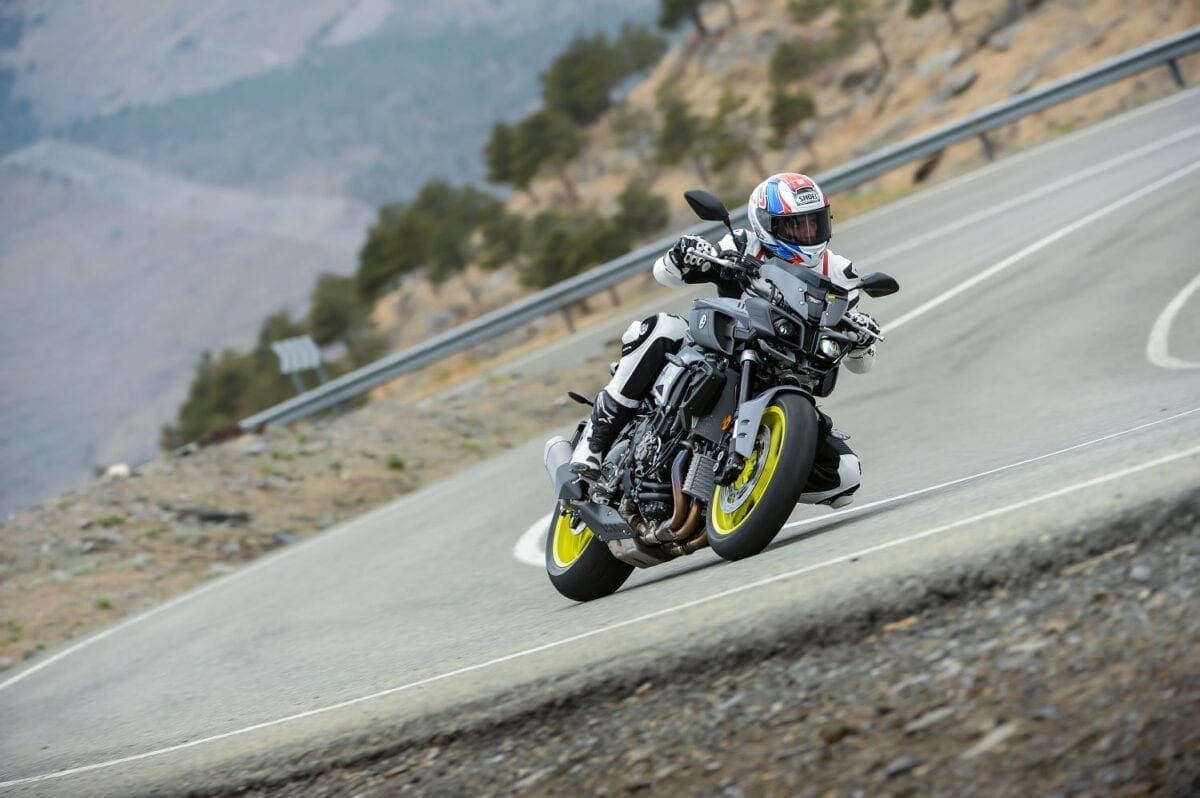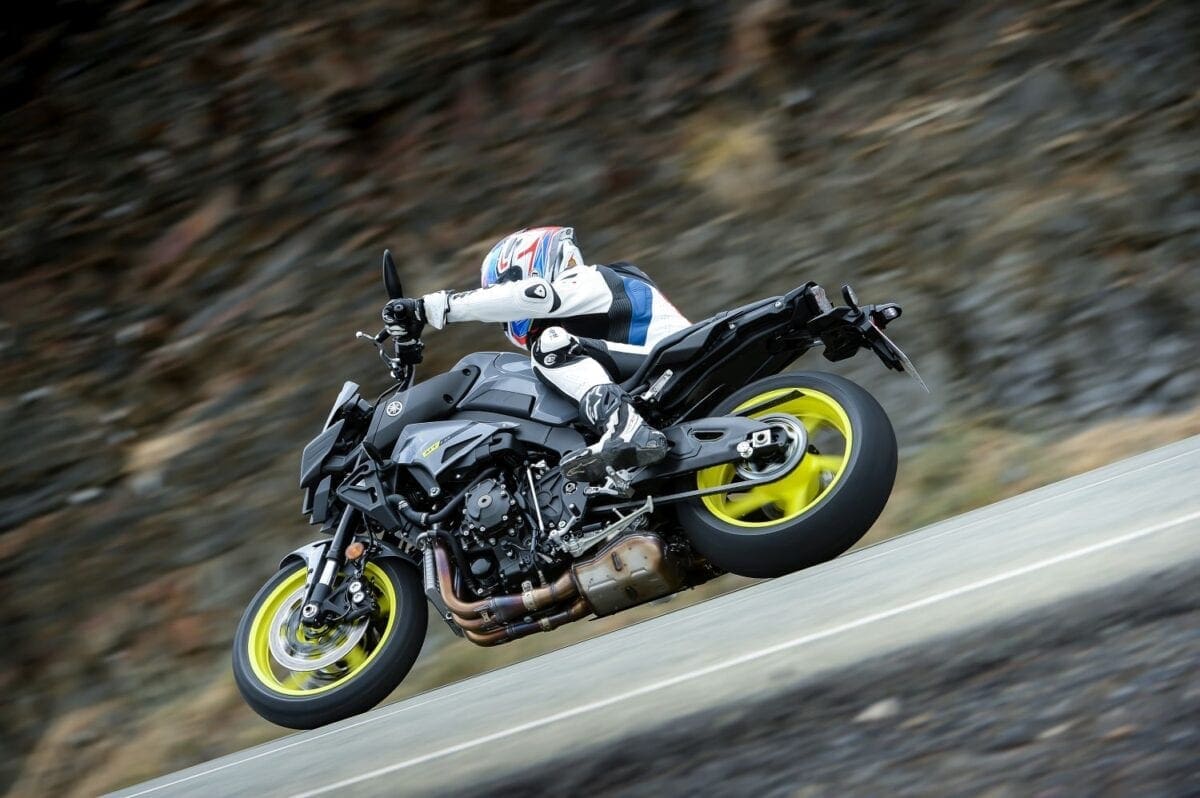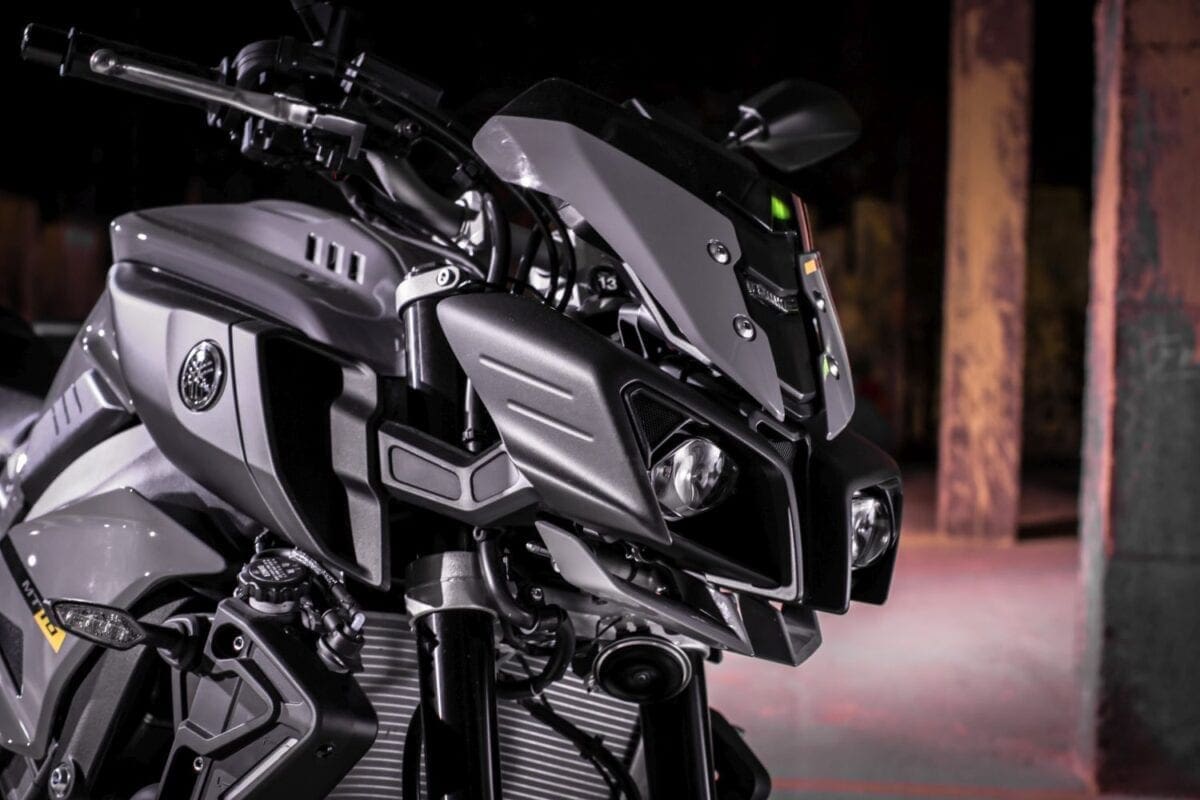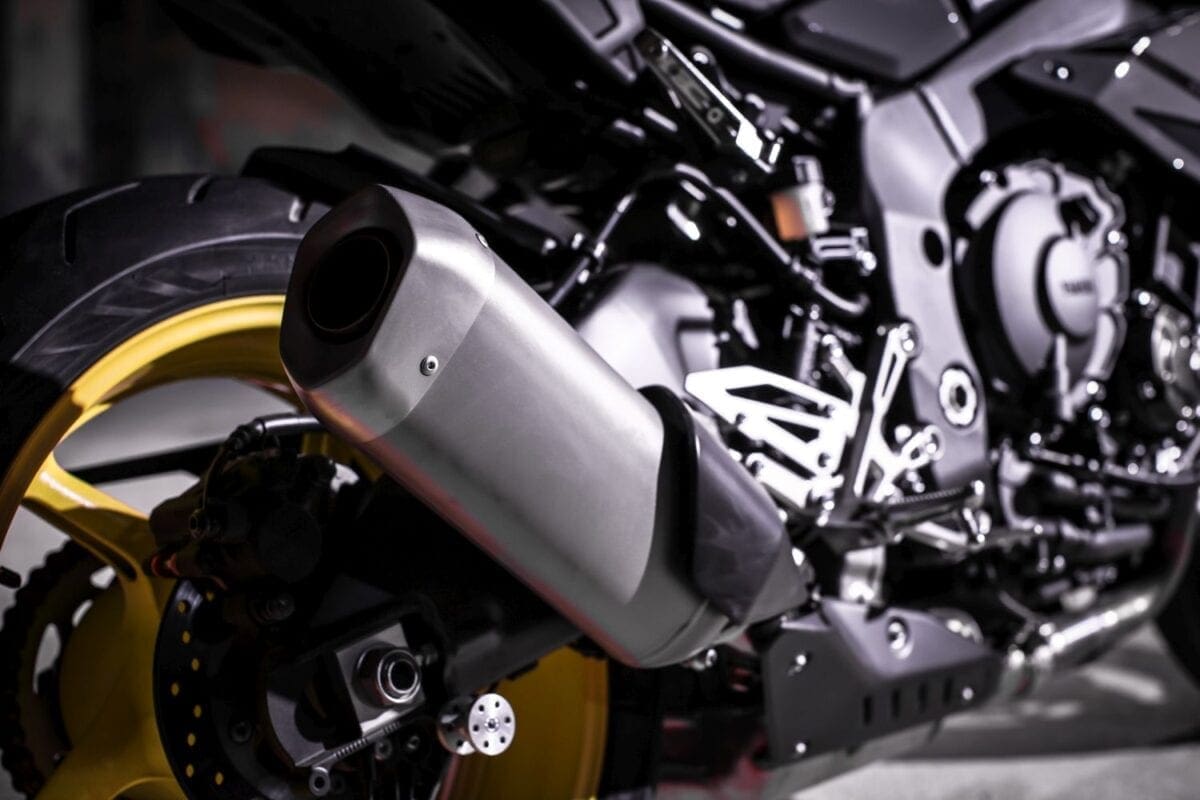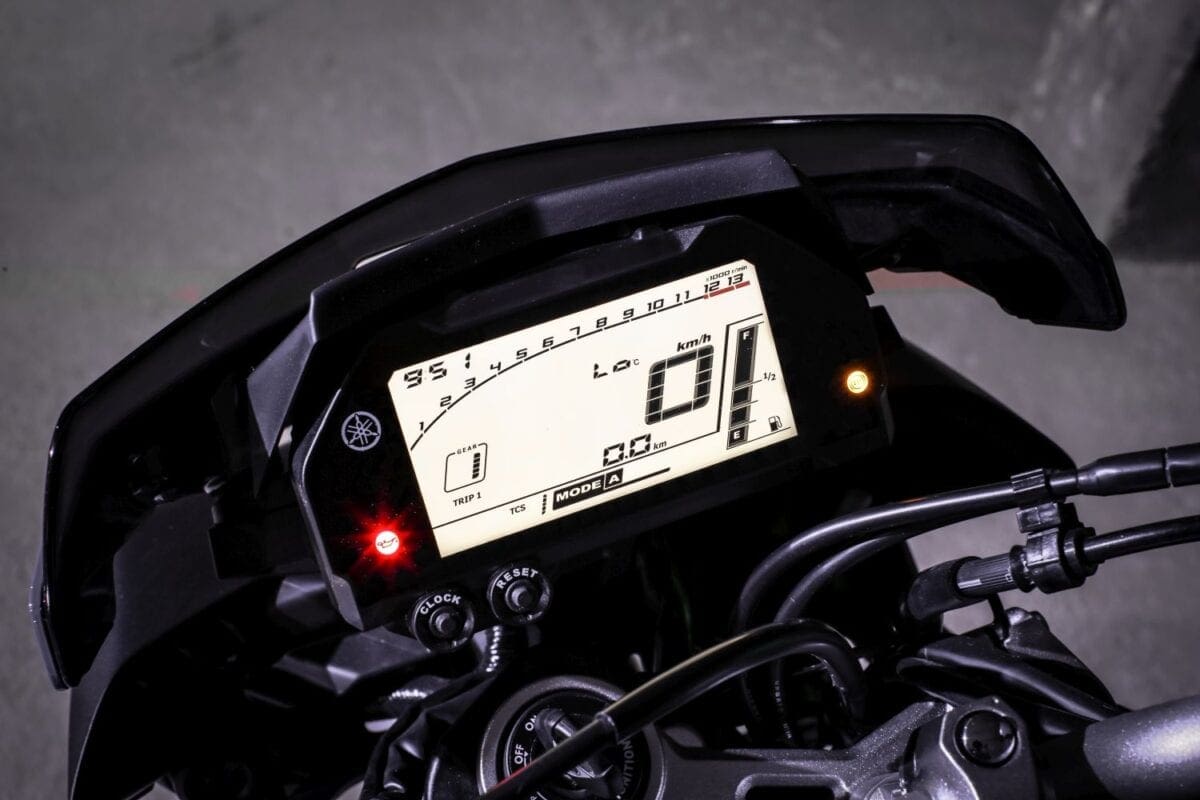By Bruce Wilson
In the two years since Yamaha’s launch of its MT-09 triple, over 65,000 MTs have rolled off the Japanese brand’s production lines. It’s an impressive number which is surely set to rocket following the release of the family’s flagship MT-10.
New bike, borrowed tech
The MT-10 is the fifth addition to Yamaha’s reinvigorated MT range, but unlike the rest of its siblings it’s the only model to have evolved using parts from an existing platform. Whilst Yamaha was extremely keen to express the MT-10 isn’t just an R1 with wide bars, on its launch in the south of Spain, it did want to emphasise the crossover of high-end components from its highly acclaimed sports bike sibling. The frame, swinging-arm, suspension and headlights all come directly from the R1, whilst it also shares the core of the sports bike’s crossplane crank in-line-four motor. To meet Euro 4 legislation and provide a more road-focused performance, an abundance of components have been changed on the engine, including the single injector throttle bodies, cylinder head, cams, pistons and valves. In a bid to reduce costs, many of the racing focused materials used in the R1’s engine have also been changed to more conventional materials. Titanium con-rods have been recast in steel, for example, whilst the remodelled crankshaft has increased in weight by some 40% – because the MT-10’s engine revs 2000rpm less than the R1’s the crank doesn’t necessitate being so light – and compression has reduced from 13:1 to 12:1. The combination of such changes has seen power figures decrease from 197bhp to a still substantial 160bhp, with a greater focus on the torque and drivability of the MT-10’s motor. The low-to-midrange delivery from the hyper naked is substantially stronger than the R1, which is partly made possible by an all-new specifically tuned exhaust system, plus a larger airbox – 12 litres instead of the 10.5l as used on the sports model.
During the MT’s presentation in an abandoned warehouse, Yamaha’s Product Planning Manager Oliver Grill highlighted the significant benefits of the torque improving, larger airbox, which necessitated a whole new design of fuel tank – having been made shorter but taller. The consequence of which meant the rider could also sit closer to the front of the bike, pairing up with the heavier engine, to alter the bike’s weight bias to 51% front. This was the first time I can recall an engineer being excited to announce the increase of a bike’s weight, but apparently it was a huge bonus in the way the bike was set to ride.
Trying one out for size
The following morning’s launch ride commenced with a thorough walk-around of the quirky looking Yamaha. Its bold styling is imaginably going to split opinion, as will the Night Fluo paint scheme which was featured on our test bikes. Reservations considered, there wasn’t a single part of the bike which stood out for being substandard or questionable. The build of the MT-10 looked premium and finished to a standard comparable with any other of its rivals in the hyper naked category. Even the exhaust looked acceptable, it’s bulky catalytic converter stashed away commendably, and after firing the crossplane crank motor into life, it won even more applause for the raucous noise emitted. The bike’s controls were easy to navigate, with information being clearly displayed on the large and well-placed LCD screen, nestled above a mini front fairing which was said to be surprisingly good at deflecting wind. The Yamaha offered three different throttle maps, plus three levels of traction control, a trip switch and cruise control – a lot of technology for a bike with a £9999 RRP. Swinging a leg over the MT’s 825mm saddle didn’t prove as challenging as expected for my 5’ 9” frame. Both of my feet were firmly on the ground, owing to its narrow nature. The wide and tall bars were only a short stretch away and felt naturally positioned, as were the brake and clutch levers. It was too early to call the bike comfortable, but it certainly seemed accommodating, especially so thanks to the length of the rider’s seat, which could have swallowed me up several times over.
Plenty of poke
Clutch pulled back, first gear slotted in without any hesitation. Virtually no revs were needed to get the wheels in motion as the burbling motor carried me off towards the main road and the start of our 200-mile test route. Mountain passes, motorways and plenty of town riding awaited us once we’d negotiated a pedestrianised zone, which forced us to ride extremely slowly and highlighted the forgiving and accommodating nature of the MT-10. It refused to get lumpy, even when the revs dropped below 2,000rpm, and surprised me with its effortless ability to pull hard and smoothly from lowdown without needing to downshift at any point in time. Before long we were on a stunning coastal pass, climbing high above the rocky terrain below and entering into a slalom of fast and flowing corners. My bike was still set with the ‘Standard’ throttle map – the least aggressive position, with ‘A’ being the middle option and ‘B’ being the most responsive – yet it showed no hesitation in blasting up to the bike’s 12,000rpm rev limiter, before I hooked another gear from the slick, six-speed gearbox and indulged once more in the addictive acceleration of the torquey and characterful motor – the noise amplifying with revs as the deep induction sound became overwhelmed by the thunderous exhaust note.
Whilst the gearbox ratios are identical to those of the R1, the rear sprocket size has been increased to a 43-tooth instead of a 41. The consequence of which is sharper acceleration which, coupled with the shorter 1400mm wheelbase, meant that the front wheel was eager to lift with every harsh opening of the throttle – unless you were riding with level 3 traction control engaged. This being the most intrusive of the options, it relentlessly intervened with the drive to the rear wheel, causing a bright orange light to flash on the dash as the sensors detected and controlled any potential slides or lifts of the front wheel. As interventions go, the system didn’t prove too intrusive, but life got much better having rolled off the throttle and selected traction level two. The exiting of corners was unmolested and I was given a much better platform to appreciate the pure brilliance of the bike’s motor, which seemed unable to disappoint me or leave me wanting for more.
Fantastic feel
Our first photoshoot took place on a tight and undulating mountain pass. By this point in the journey I’d already got to know the Yamaha’s handling characteristics pretty well, liking very much what I’d come to find. It required the most minimal of efforts to get the MT to drop into corners and the steering at slower speeds felt equally as effortless. The taught and focused R1 frame was always going to make this bike lithe, but I didn’t expect it to feel quite so plush and planted with the road surface. The fully adjustable KYB suspension needed no altering at all, constantly making the most out of the varying road surfaces being ridden. I was particularly fond of the front end feel, which seemed glued to ground in corners and filled me with so much confidence. Even on the technical and challenging photography corners, I wasn’t worried about washing the front as I accelerated into the downhill turns, knowing full well the front wheel was being made light owing to the tricky camber and transfer of weight to the rear of the bike. It never seemed to impact on the MT-10’s road holding, which would keep a constant line and tick off the apexes without any qualms. Exiting corners was just as pleasurable, thanks to the handling. With the traction control weaned off to level one, I was still full on the gas out of bends, which would cause the rear to squat and the front wheel to lift playfully. The bike’s stability was another impressive quality. The day’s ride was rich with crests and places where we could really explore the potential of the chassis. Even at high speeds, road imperfections seemed to have the most miniscule of detriments to the stable natured Yamaha, which occasionally gave the odd shrug as the front wheel skimmed skywards, but it never developed into anything even resembling a scary moment.
Well protected
During the latter part of the day we took to a section of motorway riding. The ride was so much more boring than the early sections, but it provided the perfect opportunity to discover more about the bike. We’d been told in the model presentation to be impressed by the level of wind protection from the ‘hidden cowl’ which located above the headlights. It seemed like marketing spiel at the time, but that stretch of motorway proved it was a genuine aid to rider comfort, deflecting the brunt of wind to the upper torso and helmet region. By hunching forward it was actually quite possible to stash myself out of the turbulent air and feel free of any buffeting, even at very high speeds. This opportunity also gave me the chance to try out the intuitively placed cruised control feature, which consisted of a button to arm it and a two-way switch to set and alter speeds. It worked as well as any good system should have done and was disabled when I touched the clutch, throttle or brakes. The latter components were one of the only hang-ups I had with the bike. For everyday riding, it would be hard to criticise the performance of the brakes, which never failed to haul me up in good time, but they had a very spongy and inefficient feel to them. Aside from using steel instead of aluminium pistons, they are an exact mirror of the products used on the R1, so theoretically they should have felt exceptional, but they felt a tad lethargic and failed to win me over. Another niggle was the snatchy nature of throttle positions ‘A’ and ‘B’. They certainly had a significant impact on the nature of the bike’s acceleration, making the MT’s throttle response much sharper, but they likewise caused the ride to become much less smooth and the amount of rear wheel backlash also notably increased, too. Over time, my hand could calibrate to settings, but I preferred to stick with the bike in ‘Standard’.
The last leg of the journey was a sobering one. Seven hours in the saddle had given me a real appreciation for the MT-10, which had shone on virtually every level. I didn’t want the journey to end and felt as if I could have ridden the same distance again. The considerate peg position meant I had no cramp in my legs, nor did my wrists ache from holding onto the bars. My neck should have felt strained, but it wasn’t. This bike had defied the naked stereotype and proven to be much more than just a head down, knees up un-faired rocket ship. Could you tour on this bike? Definitely so, especially if it was equipped with the multitude of factory accessories which include a high screen and semi-hard side bags. The versatility of the MT-10 had proven exceptional and won over all of us that had ridden it. Night Fluo might not have been my number one choice of the three available colours – Race Blu and Tech Black being the less intense options – but if that was the price to be paid to own such a great motorcycle then so be it. What Yamaha’s achieved with the MT-10 is nothing short of exceptional and is certain to cause a real impact in the naked bike market, making for the perfect commuter, light tourer and weekend warrior. But perhaps the best hook is its affordability. It’s hard to believe so much bike can cost under £10k; I can’t think of another model on the market so competitively priced. For this reason, plus the pleasurable riding experience, it would be naïve not to expect this to be a sell-out motorcycle for Yamaha in 2016.
Specifications: Yamaha MT-10
Engine: 998cc, liquid-cooled, in-line-four
Peak power: 160bhp (118kW) @ 11,500rpm
Peak torque: 82 ft.lbs (111Nm) @ 9000rpm
Transmission: 6-speed
Frame: Aluminium Deltabox-type
Wheelbase: 1400mm
Wet weight: 210kg
Seat height: 825mm
Fuel capacity: 17 litres
Price: £9999
Contact: www.yamaha-motor.co.uk

